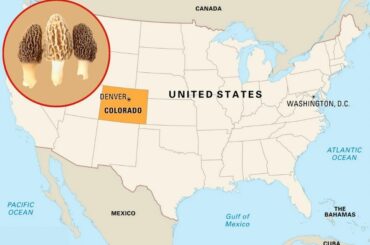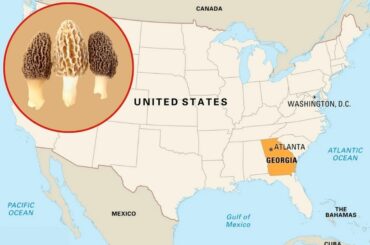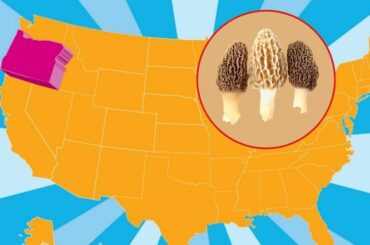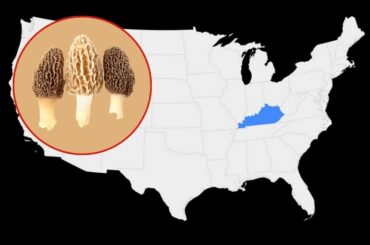Clathrus columnatus, is a fungal species that belongs to the family Phallaceae. It is commonly known as the column stinkhorn. It is a saprobic species that feed on decaying organic matter. Clathrus columnatus was first identified by the American botanist Edward Angus in 1896.
This variety of fungus is widely distributed in Africa, Australasia, and the Americas. This mushroom has very similar characteristics to other stinkhorn fungi. The fruiting body is composed of two to five long vertical orange or red colored spongy columns. These columns join together at the apex. The fully grown fruiting body grows up to a height of 8 cm. The inner surface of the columns is layered with the gleba which is a fetid olive-brown spore-bearing slime. The gleba attracts flies and other insects to help disseminate the spores.
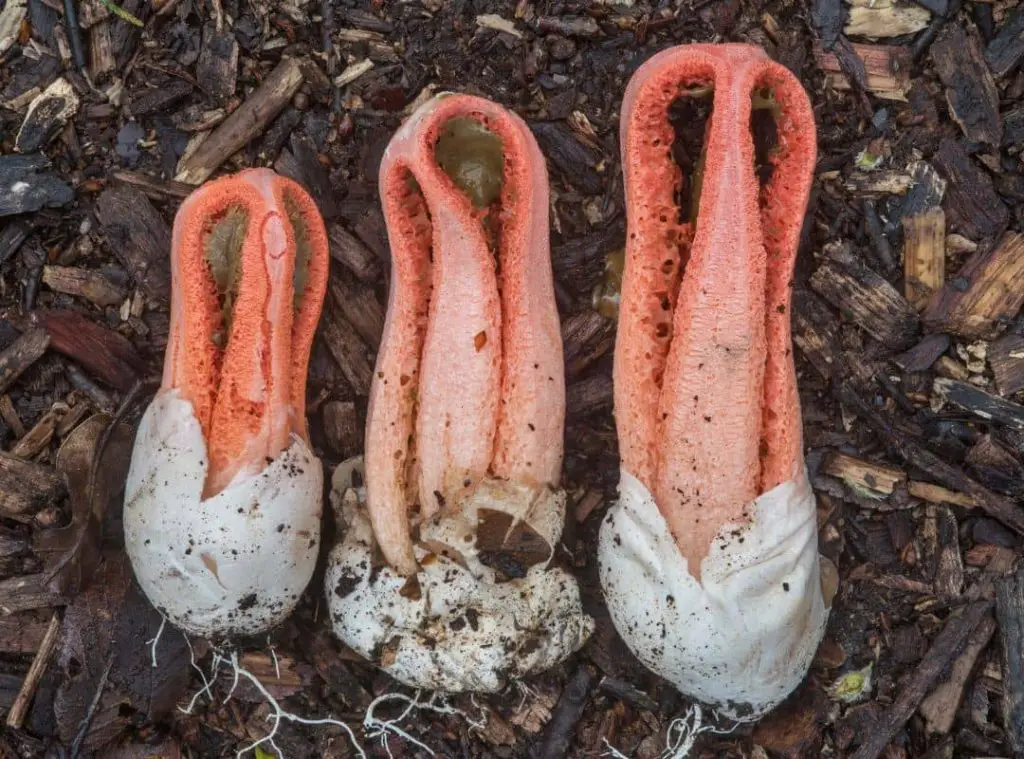
The younger stage of Clathrus columnatus is shaped like a whitish egg and grows under soil. When it matures, the egg ruptures to reveal the fruiting body. The volva which is the remaining part of the egg sac covers the base of the fruiting body.
How can you identify the Clathrus columnatus?
Contents
- 1 How can you identify the Clathrus columnatus?
- 2 What size is Clathrus columnatus?
- 3 Where can we find Clathrus columnatus?
- 4 When do Clathrus columnatus grow?
- 5 Does Clathrus columnatus contain chemicals?
- 6 Is Clathrus columnatus poisonous?
- 7 Is Clathrus columnatus edible?
- 8 The legal status of Clathrus columnatus
- 9 Are there Clathrus columnatus look-alikes
- 10 Conclusion
Cap
The fruiting body of this mushroom deviates from the conventional appearance of most stinkhorn mushroom fruiting bodies. Instead of a cage made of a complex lattice, Clathrus columnatus consists of two to five spongy vertical columns. The columns emerge separately from the volva and join together at the apex of the mushroom making an arch. The columns are joined in opposite pairs. The column pairs are joined by a short and a broad arch similar in structure to the columns. The columns are narrower at the base than at the apex. These are reddish to orange in color. At the base, the columns tend to be yellowish-pink.
The young stage of the fruiting body is encased in an egg-like structure. The egg is whitish to brownish in color. The egg sac is thin and fragile and consists of a peridium that is surrounded by a gelatinous layer that encloses the young fruiting body. The egg usually reaches the diameter of 3 to 5 cm. When the fungus reaches maturity the egg sac ruptures to reveal the red color columns. The remaining part of the egg is called the volva. It lies at the base of the mushroom covering the rhizomorphs.
Gills
Spores of this mushroom are formed in the gleba. Therefore it does not have conventional gills as in most edible mushrooms. The fruiting body of Clathrus columnatus is composed of 4-5 long arms. The inner side of the arms has a layer of olive-green spore-bearing slime called the gleba.
The gleba is where the spores are produced. The gleba is smeared on the upper inner surface of the columns. At maturity, the gleba auto digests itself and the spores are mixed in a foul-smelling, gelatinous, olive-colored substance. The gleba emits an extremely foul smell that attracts flies. The flies feed on the gleba and spread the spores. As the spores are formed in the sticky gleba, they cannot be transported via wind.
Hence the flies or other insects are needed to carry the spores around. Psilopyga fasciata, known as the stinkhorn beetle of the sap beetle family, is known to feed on the gleba of Clathrus columnatus. Similar to other stinkhorn fungi, the life cycle of this mushroom is very short and this process only takes 1-2 days.
Stem
The fruiting body of this mushroom is attached to the substrate via rhizomorphs, which are mycelial cords found at the base of the volva. These are made of two types of tissues; a central bundle of fine hyphae and an outer cortical layer of coarser hyphae. The central bundle extends in a longitudinal direction, and the outer cortical layer forms the loose but highly interwoven structure. The volva covers the rhizomorphs at the base of the mushroom.
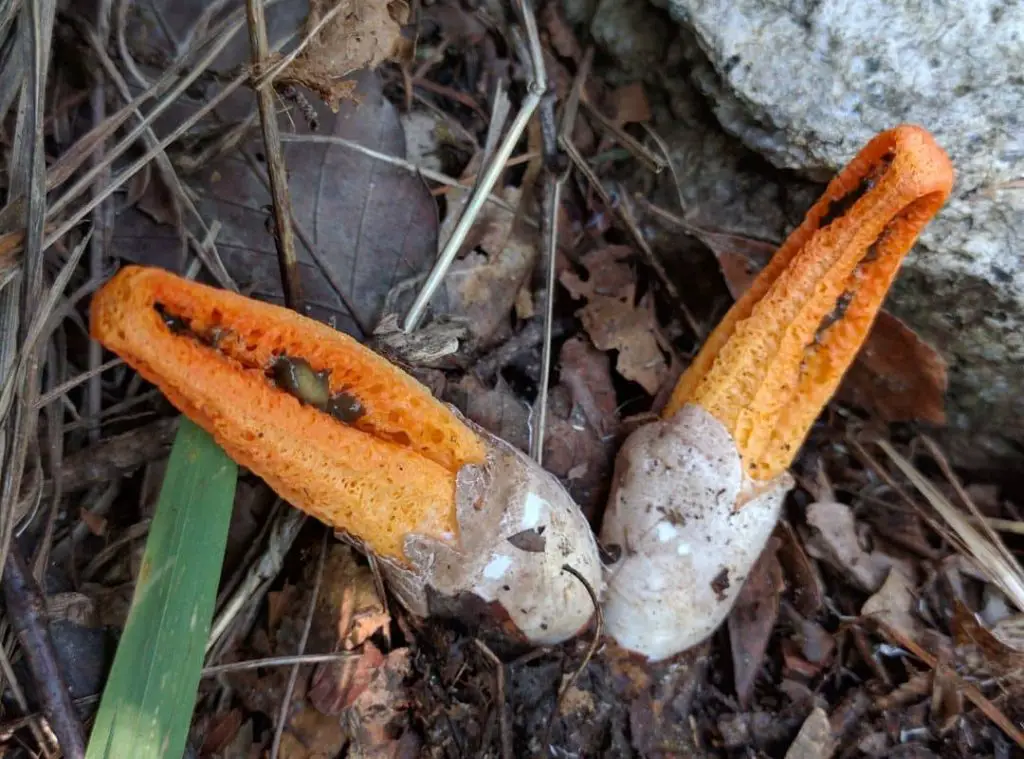
Spore print
The spores of Clathrus columnatus are produced in a matrix called the gleba. The gleba is a slimy, gelatinous substance, brown in color. The gleba covers the inner side of the arms at the apex of Clathrus columnatus.
Microscopic features
The spores of Clathrus columnatus are subellipsoid to cylindrical. The spores are smooth and 3.5–4.5 x 1.5–2 µm in size. Sphaerocysts of the branch are 16–56 µm across. They are irregular in shape, and smooth and the walls are 0.5–1 µm in thickness.
What size is Clathrus columnatus?
Full-grown columns of Clathrus columnatus grow up to a height of 5 to 8 cm above the ground. This height optimizes the spore dispersal of spores to a wider area. The columns are roughly 1 cm in width.
Where can we find Clathrus columnatus?
Like other stinkhorn fungi, Clathrus columnatus is a saprobic fungus that performs extracellular digestion to decompose dead organic matter to generate the energy they need to sustain life. Therefore Clathrus crispus is mostly found in sandy soil in areas where decaying organic matter, like wood, is abundant. It can also be found in home gardens and where wood chips or other organic matter are used as mulch in gardening. The fruit bodies of Clathrus columnatus occur solitary or in groups.
Geographically, Clathrus columnatus can be found in Australia, New Zealand, Oceania, New Guinea, Africa, and North and South America. It is collected from Costa Rica, Jiangsu, Fujian, and Guangdong in China. In North America, Fungus is distributed from New York to Mexico. It is also found in Hawaii.
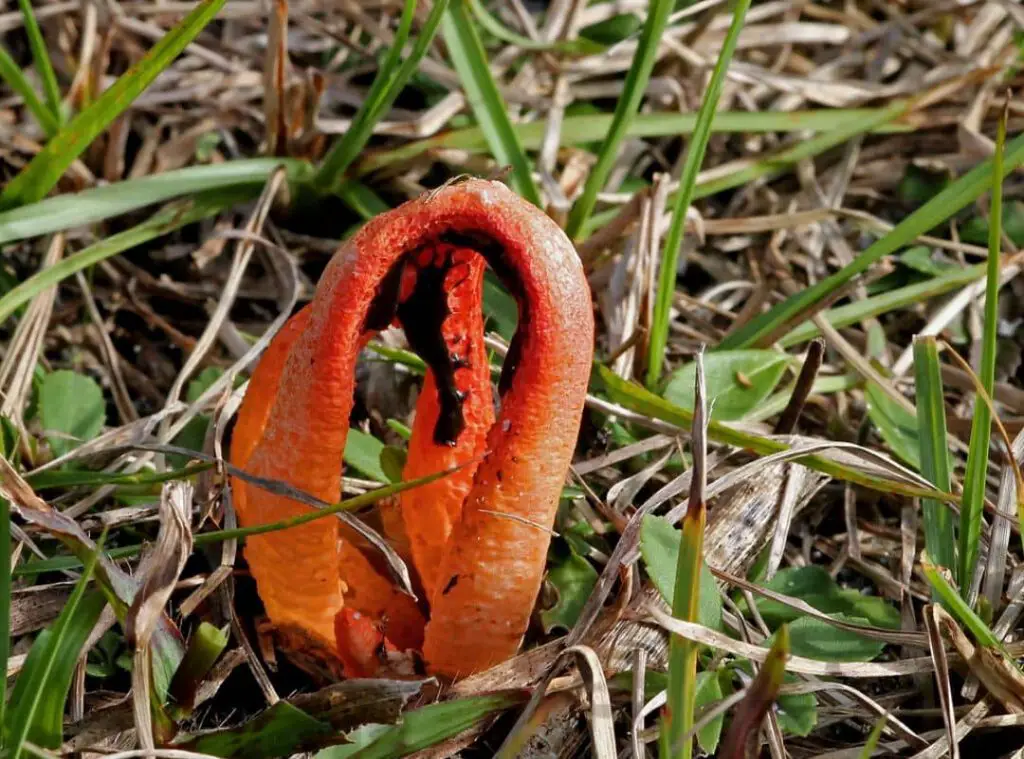
When do Clathrus columnatus grow?
Clathrus columnatus can appear a few times a year. The season is shared with other stinkhorn species which normally starts in June and ends in November. Therefore, you can spot this mushroom all around the summer, autumn, and early winter, especially after wet weather.
Does Clathrus columnatus contain chemicals?
Similar to its other counterparts, it is known to absorb and bioaccumulate manganese from the substrate similar to other species from the stinkhorn family. The bioaccumulated manganese aids the enzymatic breakdown of the gleba. This breakdown produces foul-smelling substances such as; dimethyl sulfide, aldehydes, and amines. These are produced as a result of the enzymatic decarboxylation of keto acids and amino acids.
Is Clathrus columnatus poisonous?
Clathrus columnatus is known to be inedible and in some cases poisonous. But the egg stage of Clathrus columnatus is considered edible and even considered a delicacy in some parts of the world. Since this fungal variety is not popularly consumed as a desirable mushroom, the toxicity is often measured experimentally. In some cases, the consumption of Clathrus columnatus has been reported to cause “violent convulsions followed by loss of speech and a deep sleep lasting 52 hours”. Another instance reports that consumption of Clathrus columnatus has caused death in a group of hogs.
Is Clathrus columnatus edible?
Clathrus columnatus is generally known to be inedible and sometimes poisonous. But the egg stage of the mushroom is considered edible in some parts of the world. The fungus is grown in an egg-like structure and eventually hatch and opens up which may only take a few hours. Before hatching the mushroom is considered edible but may not be a popular choice by people who have refined tastes. During the egg stage, the foul smell is slightly bearable. After the fungus hatches from its shell, this lattice-shaped fungus will start to decay.
This process draws in flies who will eat the slime on the inside of the mushroom that has a fetid smell of old cheese and in turn, will spread the spores of the mushroom to grow elsewhere.
The legal status of Clathrus columnatus
There is no information found on the legal status of Clathrus columnatus. It is not recognized as a prohibited variety of mushrooms.
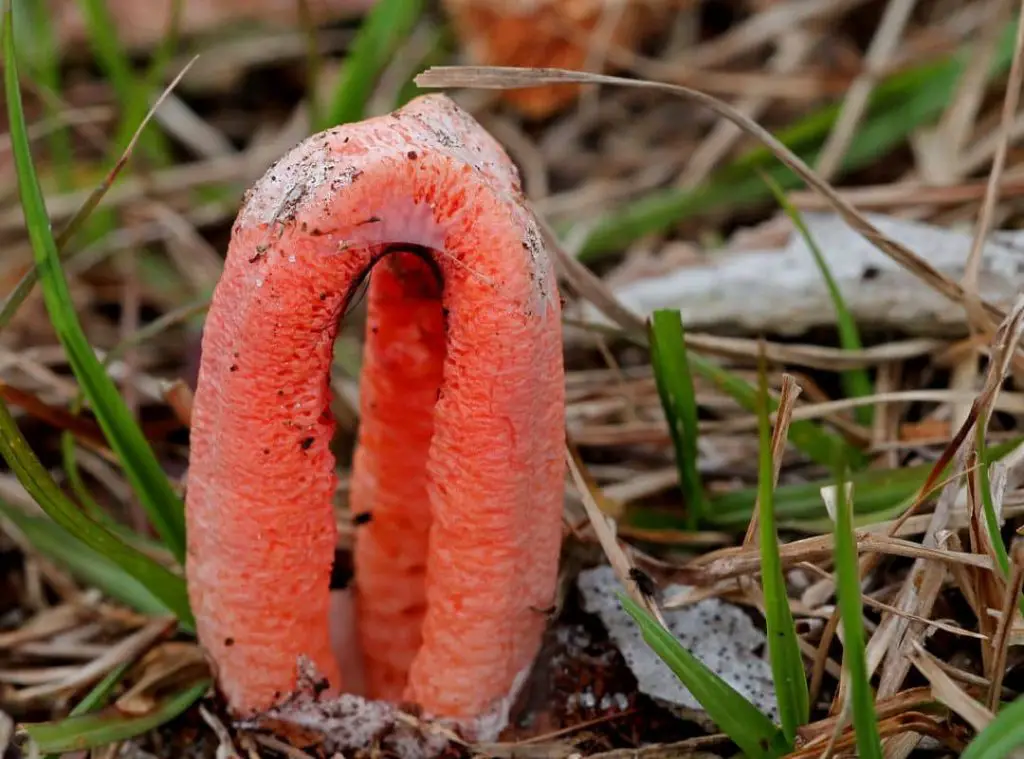
Are there Clathrus columnatus look-alikes
Most species in the stinkhorn family look more or less similar to each other. Pseudocolus fusiformis, Clathrus bicolumnatus, Clathrus ruber, Clathrus chrysomycelinus and Clathrus crispus have similarities to Clathrus columnatus. The lattice stinkhorns, Clathrus ruber and Clathrus crispus have larger, globular, lattice-like fruiting bodies.
Pseudocolus fusiformis, commonly known as stinky squid, has arms that join together at the base and detach at the top while Clathrus columnatus has arms that follow the reverse order. Pseudocolus fusiformis grows on rotting logs and chip-mulched soil while Clathrus columnatus grows on sandy soil. Clathrus bicolumnatus has a smaller fruiting body with a height of 9 cm and only has two columns. In contrast, Clathrus columnatus has a fruiting body with two to five long vertical orange or red spongy columns joined at the apex. These species can also be identified separately, under the microscope, by the size of their spores.
Conclusion
Clathrus columnatus belongs to a group of fungi that are popularly known as stinkhorn fungi. Clathrus columnatus is popularly known as column stinkhorn. Clathrus columnatus grows well in sandy soil rich in dead organic matter such as dead leaves, topsoil, and humus and even on mulch. As the name suggests, the fruiting body of Clathrus columnatus is composed of 4-5 columns merged from the substrate. Similar to other stinkhorn fungi, column stinkhorn also emits a foul smell caused by the compounds formed in the gleba. The gleba is the spore-bearing slimy substance that forms on the inner side of the arms.
The fruiting body of column stinkhorn is red in color and formed by long columns which join together at the apex. During the early stages, the fruiting body is covered by a thin whitish layer and looks similar to an elongated egg. Clathrus columnatus is not popularly known as an edible species. But the younger stage called the egg is considered edible. This variety of fungi is not considered poisonous.
Clathrus columnatus blooms several times a year and is found mostly in Australia, New Zealand, Oceania, New Guinea, Africa, and North and South America. The appearance of this fungus is not considered desirable in home gardens due to its putrid smell.
Read Next : Clathrus Crispus | An Unusual Mushroom |

